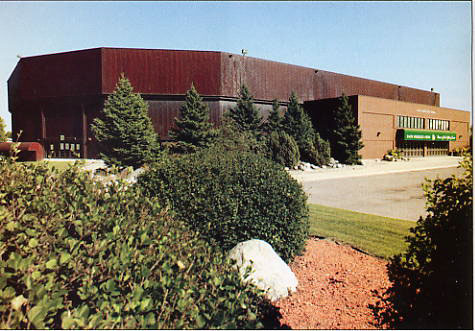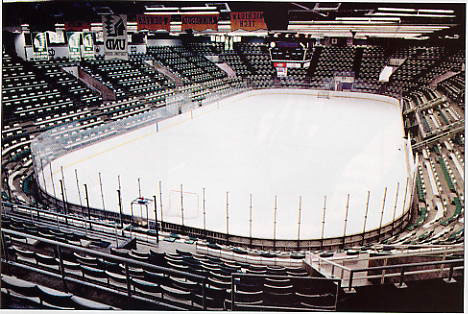
 |
Despite some bemoaning of the demise of the old "Barn" with its shortcomings that some viewed with a curious pride, fans who flocked to the new UNO hockey arena at its opening in the late fall of 1972 found an awe-inspiring sight, sparked by bright, modern and - very important - warm surroundings.
 An added bonus for the hockey program
brought by the new facility was broadening
support spurred by the comfort, class and
capacity of the Winter Sports Center. Even
people who had seemed oblivious to UND
hockey quickly and enthusiastically joined
and increased the legions of followers.
Games were not only athletic contests, but
also became social meet-and-be-met occa-
sions for those from near and far.
An added bonus for the hockey program
brought by the new facility was broadening
support spurred by the comfort, class and
capacity of the Winter Sports Center. Even
people who had seemed oblivious to UND
hockey quickly and enthusiastically joined
and increased the legions of followers.
Games were not only athletic contests, but
also became social meet-and-be-met occa-
sions for those from near and far.
The anxiously-awaited $2 million dream had its first use November 10, 1972, when the Sioux beat Colorado College, 5-4. But it wasn't a smooth road that led to that evening. A delay in State Board of Higher Education approval was begat by problems with financial backing, some of which were caused by increasing construction costs vs. funding, as well as obtaining land clearance rights. Immediately after the last of those barriers was cleared, then UND President Thomas j. Clifford turned the first shovelful of earth July 22, 1971, and 475 days later the doors were opened at the site just east of Memorial Stadium. Official dedication of the building on January 13, 1973, included a 2-2 tie with the University of Minnesota.
Funding came from $800,000 in student bonds, $500,000 from the Edmond A. Hughes Estate, $240,000 from alumni across the nation, and special friends, and $460,000 from a local fund drive. Coincidentally, the building's original cost was about 43 times more than that of the old "Barn" and about 43 times less than the cost of its successor, the new Ralph Engelstad Arena north of the main campus. Architects and engineers were Foss Associates, with UND alum Mark Foss as the lead individual.
The late John O'Keefe, Grand Forks businessman and civic leader, was the local campaign chairman. The late Len Marti, UND athletic director, and Earl Strinden, as a member of the Alumni Association staff, had responsibility for organizing the campaign.
For a new structure, the building's exterior had an odd, rusty appearance. Weathering steel was chosen by the architects and engineers because of its practical value. The high strength steel would oxidize to a coffee brown color in three or four years and would never require upkeep. It did turn that color, but some comments continued to be heard over the years about the look, as well as the sardine-can shape.
 That rather crude exterior belied the fabulous interior features which gave the Sioux
and their fans a justifiable right to boast. It
was a modern, state-of-the-art hockey arena
that took second place to no other in the
nation; indeed, country-wide acclaim poured in from
players, coaches, and others in the know.
That rather crude exterior belied the fabulous interior features which gave the Sioux
and their fans a justifiable right to boast. It
was a modern, state-of-the-art hockey arena
that took second place to no other in the
nation; indeed, country-wide acclaim poured in from
players, coaches, and others in the know.
The dazzling scene of the main arena (compared to the old building) was really something. With its banks of bright illumination (instead of spotty globe lights), glistening ice surface (produced by a reliable artificial system unaffected by the vagaries of the old cold arena), shiny plexi-glass (instead of the dented and twisted chicken wire of the previous building), alternating green and white backed seats (instead of splintery wooden planks) and a modern, multi-sided scoreboard over center ice, it brought gasps of delight and appreciation from fans and a feeling of being in the "big time," not just from a team talent standpoint. That feeling continued over the building's 29 years.
When not cheering on their team during game time, fans enjoyed other conveniences and comforts between periods. The concourse of the new Winter Sports Center meant camaraderie, where the social side of hockey games unfolded with plenty of space, easy access to refreshment stands, a puck wall featuring names of donors, and dozens of exit-entrance doors.
But the luxury and spaciousness didn't end with the building's original construction. The seating of about 5,700 was later expanded to 6,070. Fans were able to spread out even more with the addition in 1983 of a three- story, 13,816-square-foot lobby on the east side, bringing the building's size from 87,000 square feet to 100,816. Besides additional mingling space, it contained a specially designed and designated gathering place for Sioux Club members, the UND Athletic Hall of Fame, the Sioux hockey All-America wall, coaches' offices, a players' lounge and interior ticket booths that let buyers come in from the cold. The $750,000 addition was funded by the UND Foundation from part of a large testamentary gift provided by 1906 alumnus W. Kenneth Hyslop.
Facilities for spreading the word about the Sioux were provided by 69 feet of spacious boxes for news media, public address and technical personnel and scorekeepers stretched across the top of the east side of the arena. Out of sight of most people were four team dressing rooms and mechanical and ice-making equipment in the base- ment.
The precursor to the magnificent new hockey arena dedicated October 5, 2001 took place February 19, 1998, when the generic name for the second home of Sioux hockey, Winter Sports Center, went by the wayside. The building was christened Ralph Engelstad Arena in honor of the 1954 UND graduate and former Sioux goalie from Thief River Falls, Minnesota, who went on to own and manage a number of successful enterprises, including his flagship, the Imperial Palace in Las Vegas.
While the original old Barn's cold, closeness, and lack of creature comforts were thought to give the Sioux a competitive advantage, the new building, besides holding more fans, took on its own persona. And that increased as time passed.
The construction of new college hockey arenas around the country reduced it to one of the smaller arenas, but one in which the crowds became ever more overbearing and produced UND's own kind of din and distractions for visiting teams. In surveys of graduating Western Collegiate Hockey Association seniors over many years, the original Ralph Engelstad Arena was most frequently mentioned as their favorite place to play hockey.
Now, even though it still seems new in many ways despite its 29 years, the building takes its place alongside the old Barn as a former home of Sioux hockey. Unlike the "Barn," though, there are no plans to demolish it, although its exact future functions have not yet been determined.
And while that first Engelstad Arena was a huge leap forward for UND hockey, the new Engelstad Arena brings even more unimaginable benefits and splendor for one of the nation's most successful college athletic enterprises.
©SiouxSports.com copyright Jim Dahl 1994-2005 | Privacy Policy | Not affiliated with UND